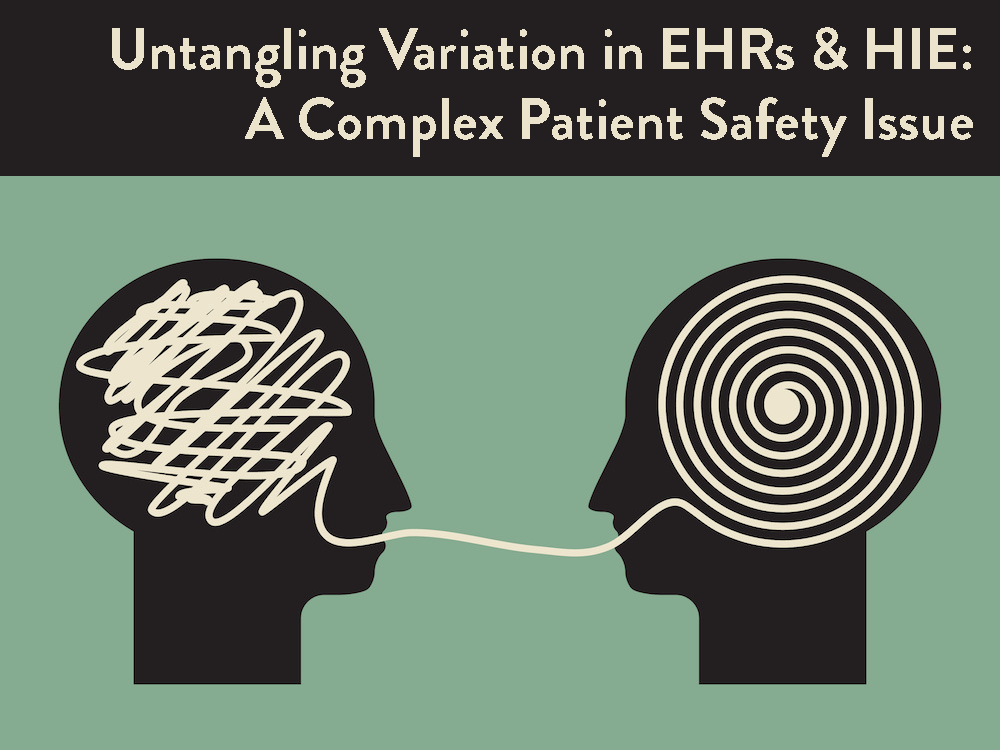The Safety Blog
The Safety Blog serves to highlight patient safety news and stories aimed at upholding our mission: safe care for every patient, every time, everywhere.
UNTANGLING VARIATION IN EHRs & HIE: A COMPLEX PATIENT SAFETY ISSUE

by Gwen O’Keefe, MD, FACP | Principal, GO Healthcare Strategy
Imagine you’ve just spent a harrowing 4 days in the hospital with sudden onset of heart problems, had many tests, and are sent home with multiple appointments and new medications. The conversations with hospital staff passed in a blur. You don’t understand what the results of some of the tests showed, but you are confident that at your appointment with your primary care doctor, Dr. Sue Caring, all will be explained.
Now, imagine you are Dr. Caring, about to see one of your favorite patients. You are dismayed that he has developed a severe cardiac condition and know he will have many questions. You prepare for the visit by reviewing the discharge summary from the hospital but are frustrated with the amount of data presented in the 15 screens of that particular hospital’s discharge summary. It looks very different than the one from a different hospital you read earlier in the day. It’s nearly impossible to quickly comb through the overwhelming amount of data to find the key 5 pieces of information you need to really make sense of what happened. You have a nagging sense of unease that you may be missing a key follow-up item and could end up dropping the ball and harming your patient.
THE PROBLEM: HOW DID IT GET THIS WAY?
Nationally, most hospitals and physician practices have adopted Electronic Health Records (EHR). At the same time, national health information standards continue to mature and a variety of options exist to facilitate electronic health information exchange (HIE).
This ready access to standardized electronic clinical information offers great promise to enhance care coordination, improve patient safety, and simplify both administrative and clinical workflows. However, to date, this promise has not been realized to the degree it should.
While there are a variety of factors responsible for this diminished return on investment, one key issue relates to variability across EHR vendors and clinical organizations in how clinical information standards are being implemented. Of particular concern are the diverse approaches taken to implement the national standard for clinical information exchange, the Consolidated Clinical Document Architecture (C-CDA). The C-CDA was designed as the vehicle to extract, summarize, and transmit clinical information from a certified EHR.
Regional clinical and informatics leaders have recognized that the wealth of variations in C-CDA exchange across EHR vendors and clinical organizations makes coordination more difficult, limits the ability of clinicians to deliver optimal care to their patients, complicates workflow, and adds frustration to already overburdened care givers. Unfortunately, this even occurs within systems where they are using the same EMR!
THE SOLUTION: WHAT’S BEING DONE ABOUT IT?
A group of leaders in a workgroup I am honored to be facilitating has determined that it is a patient safety and clinical imperative to tackle this problem and improve the use of electronically exchanged information both within and across clinical systems. In recognition of this shared need, we have come together in a collaborative effort to improve the usefulness of the C-CDA discharge transaction in this region by creating best practices for electronic information exchange that optimize use of the information, by clinicians, to improve the health of individual patients and communities in Washington State and the Pacific Northwest.
The group has been meeting since May 2018 and has made substantial progress toward creating a best practice driven by clinical needs. This work is being supported by OneHealthPort who, on behalf of the group, has engaged a national firm to provide additional technical support in matching technical standards to clinical needs. OneHealthPort’s support will enable the group to make these clinical and technical best practices available to all clinical organizations in the state and lower the barrier to adopting a common framework for information exchange.
This is a unique collaborative effort to focus on discharge summary exchange across health systems in the US. So far, similar efforts going on anywhere else in the country have not been found. Our workgroup believes that this may be because we are fortunate to have clinical leaders onboard who understand that we can use the technical capabilities to make things better, and that a solution may not be possible without this type of clinical engagement and groundwork. Technology, we believe, is only a piece of the work needed to improve safety.
“We are making excellent progress and hope to have the clinical best practice completed by early 2019 and the technical implementation guide completed soon after,” says Jeff Clarke, MD, CMIO at Confluence Health in Wenatchee. “Then we look forward to working with our own organizations and others throughout Washington to implement later in 2019. If we are successful, by 2020 we should have substantially improved the transition pathway for patients across the state, and decreased clinician burden and frustration as well. Our guiding principle is the creation of a clinically relevant standardized document for optimal transition of care.”
Stay tuned for more details in 2019!
ABOUT THE AUTHOR
 Dr. Gwen O’Keefe is a clinical informatics expert and practicing internist. Her eclectic experience over more than 20 years, and across every aspect of healthcare, has shown her the many ways information flow breaks down, frustrating patients and clinicians alike. Gwen knows there has to be a better way, and she works with leaders in healthcare who want to find and implement that way.
Dr. Gwen O’Keefe is a clinical informatics expert and practicing internist. Her eclectic experience over more than 20 years, and across every aspect of healthcare, has shown her the many ways information flow breaks down, frustrating patients and clinicians alike. Gwen knows there has to be a better way, and she works with leaders in healthcare who want to find and implement that way.
THE CASE FOR A CARE FOR THE COLLEAGUE PROGRAM
by Kit Hoffman, PsyD | BESIDE Program Coach, Confluence Health
In the year 2000, a physician named Albert Wu coined the term “second victim” to describe the experience of physicians, and other medical care providers, who make a medical mistake. The patient, of course, is the first victim of a medical mistake. The medical care provider, who feels guilt, shame, anger, and helplessness following a medical mistake is the second victim.
Following a medical error, research shows that physicians, in particular, may also experience anxiety about making another error, loss of confidence in their abilities, difficulty sleeping, decreased job satisfaction, and harm to their reputation among other things.
THE 6 STAGES OF A SECOND VICTIM
Sue Scott and colleagues (2009) identified a traditional 6-stage trajectory to the process a provider goes through when involved in a medical error:
(1) chaos and accident response
(2) intrusive reflections
(3) restoring personal integrity
(4) enduring the inquisition
(5) obtaining emotional first aid
(6) moving on
After the last stage, Sue Scott and her colleagues (2009) found that the second victim will either go on to drop out, survive, or thrive. Dropping out includes leaving the profession or practice. Surviving is when the second victim is doing well enough to function but still has difficult memories, thoughts, or emotions related to the event. Finally, thriving includes finding some meaning in the event and possibly even growing from it.
THE PITFALLS OF PERFECTIONISM
“Systems that realize that health care providers are human and fallible have a better chance of catching and fixing errors before they reach the patient.”
Wu (2000) describes how a societal expectation for perfection not only increases shame when a medical mistake occurs, but also makes it difficult to report and remedy systemic errors, as people are hesitant to admit that they are not conforming to expectations of perfection. Even when a healthcare professional realizes that expectations of perfection are unrealistic, the societal pressure to perform at such high levels is immense.
Of course, perfect patient care is a worthy aspiration. This is not the same, however, as expecting perfect performance. To achieve this self-correcting system, healthcare professionals must feel comfortable reporting and talking about mistakes.
THE IMPACT OF PROACTIVE SUPPORT
To help healthcare professionals feel safe talking about their own mistakes, providing organizational support is essential. Ideally, this organizational support should include some form of emotional support, with an understanding that medical mistakes can have psychological impacts on all members of the care team involved with the patient. Providing this service proactively is important when working with healthcare professionals, as they tend to avoid seeking help for their mental health due to many factors in the culture of medicine that create stigma surrounding mental health (see Wallace, 2010 for a discussion).
WEBINAR – CARE FOR THE COLLEAGUE: BRINGING ENCOURAGEMENT AND SUPPORT IN DIFFICULT EVENTS
At Confluence Health, emotional support for providers and employees is fostered through a Care for the Colleague Program called . On September 27, 2018 I presented a webinar on this topic and the BESIDE program for the WPSC.
WEBINAR LINK: The recording from this webinar can be found here.
SLIDES LINK: The slides from this webinar can be found here.
My hope is that this webinar will help organizations embrace support for second victims as well as foster dialogue about de-stigmatizing mental health of healthcare professionals. When things go wrong with patient care, the best things we can do are listen to each other, offer support, and be okay with emotional pain. It takes a lot of courage for healthcare professionals to help patients day in and day out. It takes even more courage for healthcare professional to get help for themselves, and we can make it easier.
ABOUT THE AUTHOR
 Kit Hoffman, PsyD is developing and implementing the BESIDE Program at Confluence Health in Central Washington. BESIDE stands for Bringing Encouragement and Support in Difficult Events. BESIDE is Confluence’s Care for the Colleague program that supports healthcare providers involved in adverse patient events. Dr. Hoffman holds a Doctorate Degree in Clinical Psychology from the Chicago School of Professional Psychology in Los Angeles, California. Before coming to Confluence, Dr. Hoffman had a background in health psychology. In 2017, she completed her internship as a Behavioral Health Consultant at HealthPoint in Seattle, Washington. While she was at HealthPoint, she saw the need for providing support to overburdened medical professionals. Dr. Hoffman is passionate about delivering quality healthcare by supporting the wellbeing of our healthcare providers. To support her own wellbeing, Dr. Hoffman spends as much time as possible in the healing space of nature.
Kit Hoffman, PsyD is developing and implementing the BESIDE Program at Confluence Health in Central Washington. BESIDE stands for Bringing Encouragement and Support in Difficult Events. BESIDE is Confluence’s Care for the Colleague program that supports healthcare providers involved in adverse patient events. Dr. Hoffman holds a Doctorate Degree in Clinical Psychology from the Chicago School of Professional Psychology in Los Angeles, California. Before coming to Confluence, Dr. Hoffman had a background in health psychology. In 2017, she completed her internship as a Behavioral Health Consultant at HealthPoint in Seattle, Washington. While she was at HealthPoint, she saw the need for providing support to overburdened medical professionals. Dr. Hoffman is passionate about delivering quality healthcare by supporting the wellbeing of our healthcare providers. To support her own wellbeing, Dr. Hoffman spends as much time as possible in the healing space of nature.
WORKS CITED
Scott, S. D., Hirschinger, L. E., Cox, K. R., McCoig, M., & Brandt, J. (2009). The natural history of recovery for the healthcare provider ‘‘second victim’’ after adverse patient event. Quality and Safety in Health Care, 18, 325-330. doi:10.1136/qshc.2009.032870
Wallace, J. (2010). Mental health and stigma in the medical profession. Health, 16(1), 3-18. doi:10.1177/1363459310371080
Waterman, A. D., Garbutt, J., Hazel, E., Dunagan, W. C., Levinson, W., Fraser, V. J., & Gallagher, T. H. (2007). The emotional impact of medical errors on practicing physicians in the united states and canada. Joint Commission Journal on Quality and Patient Safety, 33(8), 467-674.
Wu, A. (2000). Medical error: the second victim: the doctor who makes the mistake needs help too. BMJ: British Medical Journal, 320(7237), 726.




